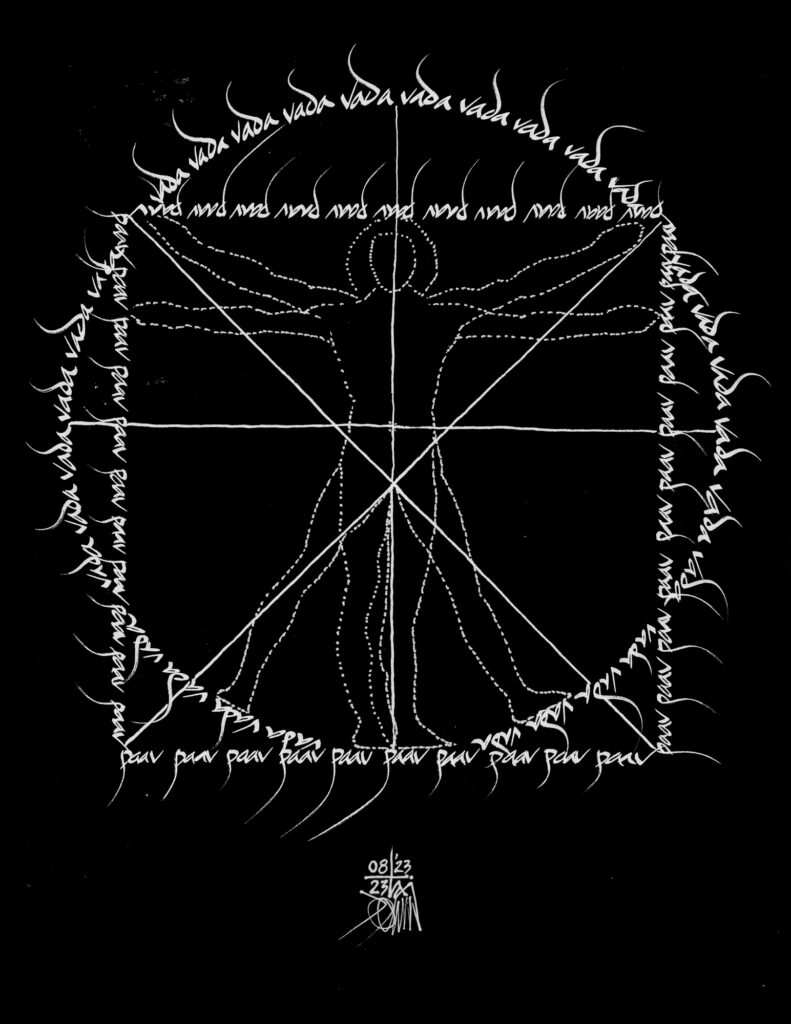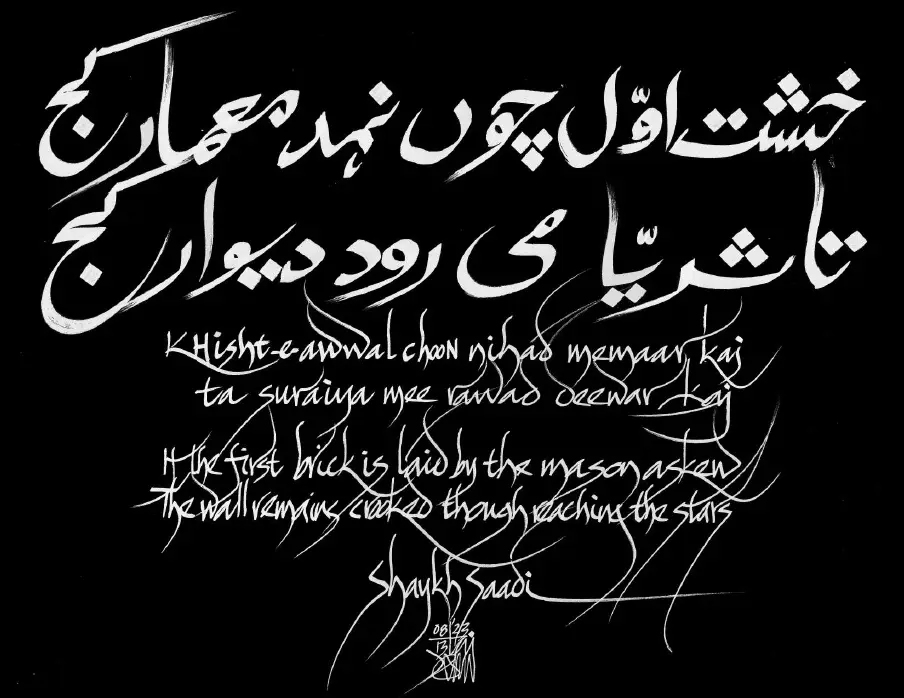
I thought of Vada Pav while purveying the audience in the newly minted auditorium of Carleton University’s Health Sciences building, which had gathered to hear my talk on Vitruvian Man as a Renaissance Selfie with the giant screen displaying Leonardo da Vinci’s self-portrait occupying both the circle and the square, a time-lapse image predating cubism.

More precisely, I recollected crossing the street from Flora Fountain, dodging traffic, repelled by exhaust fumes but drawn to the spicy aroma wafting from C T O Vadapav at the heart of Mumbai.
The Vada Pav is an architect’s gastronomical delight as it is the conjunction of the cubical sliced bread with the sphere of mashed potato patties mixed with chopped onion, green chillies, coriander, and spices, dipped in chickpea batter and fried, slathered with tart tamarind and fragrant green chutney of chilli and coriander and the tongue-tickling theekha red ghati masala made of Byadagi chillies and sandwiched in the Pav, served, with a pair of green Lavangi chillies with their hint of tanginess and sweetness, on a square cutout of yesterday’s newspaper. The piquant aroma floods your nostrils before your teeth sink into the trifecta of sweet, sour and spicy flavour notes, and you get the delectable taste of amchi Mumbai, never to be forgotten.
The Vada Pav was an appetizer for the main course to follow. While still munching, feasting on food, I would turn the corner to pick up food-for-thought remaindered discounted books displayed on the fence and sidewalk on the way to Churchgate station for my in-train reading heading home.
The memory of steaming hot Vada Pav from Mumbai can make you salivate in snow-laden Ottawa—the perfect antidote to the mouth going dry before a talk. There was a good turnout as CBC had done a curtain-raiser interview on the Renaissance Selfie, intrigued by a professor who had never taken one as he preferred to live without a cell phone.
The most famous diagram in the world by the vegetarian Leonardo da Vinci and the lionized Vada Pav are both based on a square and a circle. Furthermore, the relationship between the two figures in both cases is the same: the centres of the square and the circle do not coincide as the circle is tangent to one edge of the square and emerges out from the other side(s) as does the Vada encased in the Pav. The off-centeredness is due to down-to-earthness in one case and cosmicness in the other.

Leonardo was responding to Vitruvius, the father of Western Architecture, when, speaking of proportions, he observed:
In the human body, the central point is the navel. If a man is placed flat on his back, with his hands and feet extended and a compass centred at his navel, his fingers and toes will touch the circumference of a circle thereby described. And just as the human body yields a circular outline, a square may also be found in it. If we measure the distance from the soles of the feet to the top of the head and then apply that measure to the outstretched arms, the breadth will be the same as the height, as in the case of a perfect square. — Vitruvius in De Architectura, Book 3
Many have attempted to illustrate the Vitruvian proposition of proportions. For instance, the later Quattrocento architect Francesco di Giorgio Martini did one ten years before Leonardo. One of Francesco’s codices was even in Leonardo’s Library, much annotated by him. But as my friend Claudio Sgarbi Giacomo has argued, Andrea da Ferrara, Leonardo Da Vinci’s close associate, proved to be the catalyst. He initiated the diagram with many iterations that paved the way for Leonardo’s single and singular pristine final icon of Western Art.
In Leonardo Da Vinci’s Vitruvian Man diagram, the centre of the square is at his groin, while the circle’s centre coincides with his navel. The square represents charting the Earth’s four corners, while the circle symbolizes heaven. Hence, while he stands on the ground, he occupies the square but is aloft, spreadeagle in the air to occupy the circle. The upward move is also a shift from the square’s centre of Earth’s sensuous fecundity to the circle’s centre of the heavenly umbilical cord; the trace of the body being birthed bears witness to the creation miracle.

Five centuries before Leonardo, the Muslim philosophers of 10th century Iraq, the Ikhwān Al-Ṣafā or Brethren of Purity, had disagreed with the Vitruvian Man centres parity by arguing the navel was the true centre of the body and not the groin as the navel was the centre of the human being at birth. Only at seven years, the centre begins to descend to reach the sacrum.
Leonardo, jumping spread eagle like a latter-day cheerleader, visually restores the omphalos of Ikhwan Al-Safa: the centred navel. He does so by using the head as 1/8th of the body, just as Abu Ali Muhammad ibn Ali ibn Muqla codified in Arabic calligraphy (Leonardo coincidentally wrote from right to left). The first Arabic letter as a vertical and veridical datum consisted of 8 rhombic strokes of the pen, i.e. eight rotated-squares conjoined vertex to vertex (other numbers are also permissible, but the eight-fold division clarifies the golden ratio with the navel occurring at 3:5).
Thus, the width of the slanted nib determined the height of the letter, and together, they formed the diameter of a circle that is the field of all subsequent Arabic letters. Arabic is calligraphy on steroids, not for the faint-hearted, as your first move charts your destiny, just as Shaykh Saadi’s verse on foundational movements emphasized:

In the Vada Pav, the square bun is hinged on one side, displacing the spherical Vada off-centre as it bulges out of the pav cuboid, enticing you to come for the ride. With your first bite, your gustatory and olfactory ascension heavenwards begins.
I eat Vada Pav; therefore, I am.

However, the jugalbandi of earthly squares with heavenly circles has shifted your mind from tasting food to examining the food for thought. You realize the pursuit of gastronomic delights in particular, and the pursuit of pleasure generally belongs to the earthly square. Indeed, if the purpose of pleasure and avoidance of pain is the cornerstone of Liberal Utilitarianism, best encapsulated in the “Greatest Happiness Principle” which is supposedly the centre of our being, then that centre is the centre of the square at the groin, which is a descent from the centre of our birthright that is the centre of the heavenly circle that lies at our navel.
The centre of the heavenly circle lies at the navel of those individuals who have transcended their ego. When it comes to the purpose of life, they affirm it goes beyond pursuing pleasure and avoiding pain. They deem those pursuits trivial and the “Greatest Happiness Principle” unprincipled. Their understanding of being is akin to that word in Arabic: wujud, which comes from wajada, implying both “finding” and to be “found.”
The Vada Pav reminds you of your yearning to be perfected. To be is to find. To be is to be found.
To break bread is to share your meal with someone. But you break bread not to share but to insert the unbroken Vada in the broken Pav. While you seek your centre in the broken squares outside, the intact centre of the heavenly circle continues within you.
Author’s note: The above Vitruvian Vada Pav diagram, the Vada Pav Poem and Brick by Shaykh Saadi are all available on Academia: Calligraphy. The talk Vitruvian Man as a Renaissance Selfie was delivered during Carleton University’s year-long Leonardo da Vinci Cinquecento Celebration as part of a trifecta: opening with Leonardo da Vinci: from Bagdad to Bayazid (a Faculty of Public Affairs Research / Islamic History Month event) and ending with Leonardo da Vinci’s Mirror Writing as part of the inaugural SmarTalk at the Cinquecento finale. See: Academia: Talks.








